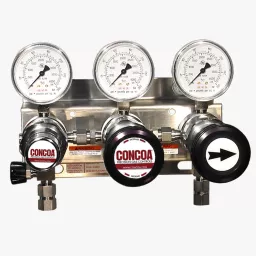Cryosurgery, also called cryotherapy or cryoablation, uses extreme cold to freeze and destroy damaged or diseased tissue. Cryosurgery can be performed externally to treat surface skin conditions such as warts and skin tags, or internally using a cryoprobe to treat cancers or tumors inside the body. A cryoprobe uses at least 3500 PSIG (240 BAR) of high pressure argon in gaseous form. The gas is pumped into the tip of a cryoprobe and expanded through a minute pore. This expansion causes the Joule-Thomson effect and produces ice crystal formation at the tip of the cryoprobe, which is needed to freeze tissue.
Some cryosurgery procedures require alternating freezing and thawing cycles. With the addition of an electrical heater in the cryoprobe, the argon gas is used for freezing and also used to heat the cryoprobe shaft by spreading the heat from the electric heater for thawing. On the other hand, argon gas may be used for the freezing cycle, and helium gas may be used for thawing. For the withdrawal of argon or helium from high pressure cylinders, the CONCOA 492 Series regulator provides primary pressure control at inlet pressures up to 6000 PSIG (415 BAR). The addition of a 529 Series protocol station or 529 Series protocol alarm station permits convenient wall mounting or connection to multiple cylinders of the same gas. The protocol alarm station, featuring the CONCOA Altos 2 remote alarm, provides the added security of audible and visible alerts before a switchover occurs.
For larger hospitals and ambulatory surgical centers actively involved in cryosurgery procedures on a daily basis, the CONCOA 530 Series pressure differential switchover provides a continuous supply of argon gas with fill pressure as high as 6000 PSIG (415 BAR). Multiple inlet configurations permit up to two cylinders per side, thereby streamlining the handling of gas cylinders. Additionally, the 530 Series switchover is designed to interface with the CONCOA Altos 2 remote alarm.
When using oxygen-depleting gases like argon and helium, CONCOA recommends installing an appropriate air monitoring system anywhere these gases are stored and used. The 580 Series oxygen deficiency monitor provides continuous monitoring of areas where oxygen displacement may occur. The monitor may be used as a stand-alone gas detector, with the 585 Series emergency shut-off controller or emergency stop button, or connected to a centralized gas monitoring system, thus providing an economical way to maintain a safe work environment and meet facility regulations.
while sparing nearby healthy tissues and skin. of cryogenic gas, such as liquid nitrogen, to freeze and destroy diseased tissue while sparing nearby healthy tissues and skin. Cryosurgery was most widely used to treat skin conditions such as warts and lesions but has become more commonly used as a tool to remove cancerous tissue in general surgery, dermatology, oncology, proctology, and urology procedures. CONCOA specializes in the manufacture and design of cryogenic gas equipment used in the transfer and dispensing of cryogenic fluids for cryosurgery. applications, such as cryogenic check valves, cryogenic transfer hoses, cryogenic vapor vents, cryogenic headers, vacuum-jacketed hoses, and CONCOA 400 Series regulators. CONCOA’s vacuum-jacketed piping system is the most efficient way to transfer cryogenic liquids and CONCOA’s 492 Series regulators, with encapsulated seat design, are optimal choices for cryogenic surgery. For cryosurgery procedures using a cryoprobe,
Cryosurgery, also called cryotherapy or cryoablation, uses extreme cold to freeze and destroy damaged or diseased tissue resulting from a variety of medical conditions from warts and skin tags to cancers or precancerous lesions. Cryosurgery can be performed externally to treat surface skin conditions, or internally using a cryoprobe to treat cancers or tumors inside the body.








